Unlocking Your Potential: The Power of Visualization for Daily Success
Ever wondered how some people seem to effortlessly achieve their goals while others struggle? The secret might be simpler than you think. It’s all about the power of visualization. This isn’t some new-age mumbo jumbo - it’s a tried and tested technique used by top athletes, successful entrepreneurs, and everyday achievers to boost their productivity and reach their dreams.
So, what exactly is visualization? Think of it as mental rehearsal. It’s like creating a movie in your mind where you’re the star, crushing your goals and living your best life. But it’s not just about daydreaming. Effective visualization engages all your senses, making the experience feel as real as possible.
Let’s say you’ve got a big presentation coming up. Close your eyes and imagine yourself walking into the room, confident and prepared. Feel the weight of your laptop in your hand, hear the murmur of voices as you set up, smell the fresh coffee in the air. Picture yourself delivering your points with clarity and conviction, see the nods of approval from your audience. By the time you actually step into that room, it’ll feel like you’ve done it a hundred times before.
Now, before you start visualizing world domination, let’s talk about setting realistic goals. The key is to be specific and measurable. Instead of “I want to be successful,” try “I want to increase my sales by 20% this quarter.” This gives your brain a clear target to focus on.
There are two main types of visualization: outcome and process. Outcome visualization is all about the end result. Picture yourself crossing that finish line, receiving that promotion, or hitting that sales target. Feel the rush of accomplishment, the pride in your achievement. This type of visualization helps keep you motivated when the going gets tough.
Process visualization, on the other hand, is about the journey. It’s visualizing each step you need to take to reach your goal. If you’re working on a big project, see yourself breaking it down into manageable tasks, tackling each one with focus and determination. This helps you stay on track and makes the path to success feel more achievable.
One of the coolest things about visualization is its power to boost motivation. When you regularly picture yourself succeeding, it creates a sort of mental momentum. You start to believe in your ability to achieve your goals, which in turn makes you more likely to take the actions needed to make them a reality.
But let’s be real - life can be stressful, especially when you’re pushing yourself to achieve big things. That’s where visualization can really come in clutch. By imagining yourself calm and composed in high-pressure situations, you’re training your brain to handle stress better. It’s like a mental dress rehearsal for dealing with challenging situations.
So, how do you make visualization a part of your daily routine? Start small. Set aside just 5-10 minutes a day, maybe right after you wake up or before you go to bed. Find a quiet spot where you won’t be disturbed, get comfortable, and let your mind do its thing. As you get more practiced, you can increase the duration and frequency of your sessions.
Visual cues can be super helpful in boosting your visualization practice. If you’re working towards a fitness goal, put up a picture of your ideal physique somewhere you’ll see it often. If you’re saving for a dream vacation, set your phone background to a picture of your destination. These little reminders help keep your goals front and center in your mind.
Visualization isn’t just for solo success - it can be a game-changer for team productivity too. If you’re part of a team, try using visual cues to communicate focus time or celebrate achievements. A simple “do not disturb” sign or a jar filled with marbles representing completed tasks can go a long way in boosting team morale and productivity.
Now, let’s talk about some practical tips to supercharge your visualization practice. Consistency is key - make it a daily habit, just like brushing your teeth. If you’re struggling to get started, try using guided imagery scripts or apps. These can help you get into the right mindset and provide structure for your practice.
Combining visualization with positive affirmations can be incredibly powerful. As you picture yourself succeeding, repeat phrases like “I am capable of achieving my goals” or “I have the skills and determination to succeed.” This helps reinforce positive beliefs and align your thoughts with your desired outcomes.
Mental rehearsal is another great technique. Before important events or challenging situations, take some time to visualize yourself going through them successfully. This can help reduce anxiety and improve your performance when the real moment arrives.
Let’s look at some real-life examples of visualization in action. Michael Phelps, the most decorated Olympian of all time, used visualization extensively in his training. He would imagine every detail of his races, from the feel of the water to the sound of the starting gun. This mental preparation played a huge role in his incredible success.
Entrepreneurs often use visualization to map out their business goals. They might picture their company growing, their products flying off the shelves, and their team working together seamlessly. This helps them stay focused on their vision and make decisions aligned with their long-term goals.
Even students can benefit from visualization. Imagining themselves acing an exam can help boost confidence and reduce test anxiety. It’s like giving your brain a preview of success, making it more likely to happen in reality.
Now, it’s important to remember that visualization isn’t a magic wand. You can’t just sit on your couch visualizing success and expect it to materialize out of thin air. Visualization is a tool to support and enhance your real-world efforts, not replace them. It’s about creating a mental foundation for success, not a substitute for hard work and perseverance.
Some people might wonder how often they should practice visualization. While daily practice is ideal for maintaining focus on your goals, the most important thing is to find a rhythm that works for you. Even a few minutes of focused visualization a few times a week can make a difference.
It’s also worth noting that visualization can’t guarantee the achievement of your goals. Life is unpredictable, and there are always factors outside our control. However, regular visualization can significantly increase your chances of success by keeping you motivated, focused, and resilient in the face of challenges.
As for the best time to visualize, it really depends on your personal preferences and schedule. Some people find it energizing to start their day with visualization, while others prefer to use it as a way to wind down in the evening. Experiment with different times and see what feels most effective for you.
In conclusion, visualization is a powerful tool that can transform your approach to daily productivity and goal achievement. By regularly picturing your desired outcomes and the steps to get there, you can enhance your motivation, manage stress more effectively, and stay laser-focused on what truly matters to you.
Whether you’re an athlete aiming for gold, an entrepreneur building your empire, or simply someone looking to get more out of each day, incorporating visualization into your routine can be a game-changer. So why not give it a try? Take a few minutes each day to close your eyes, imagine your success, and watch how it starts to impact your life in meaningful ways. You might be surprised at just how powerful your mind can be when you learn to harness its full potential. Remember, the first step to achieving your dreams is being able to see them clearly in your mind’s eye. So go ahead, start visualizing your path to success today!






